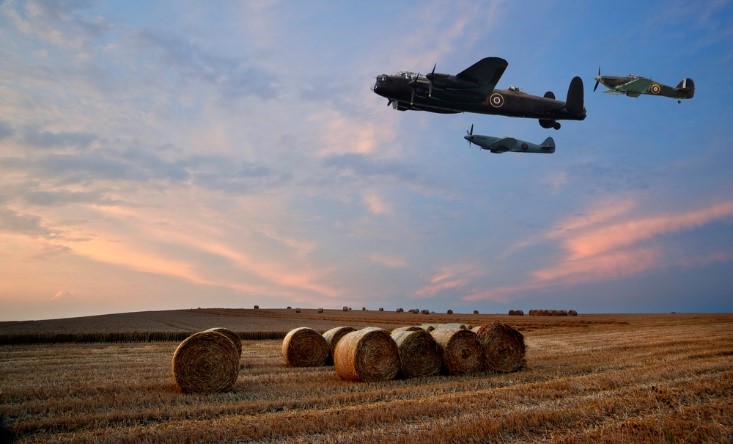

The Royal International Air Tattoo
Eleanor Lashford, an Operational Meteorologist from the Met Office, provides a first hand account of the preparation involved in providing the weather services for the Royal International Air Tattoo (RIAT). On Monday 9th July 2018, Eleanor and three other Meteorologists from the Met Office, headed to RAF Fairford in Gloucestershire for RIAT 2018, famously known for being the world’s greatest and largest military airshow. This year it commemorated the past achievements of the Air Force in its 100 years, as well as celebrating the present, and helping to inspire the future of the RAF.
The airshow is staged by The Royal Air Force Charitable Trust Enterprises (RAFCTE). RIAT ticket sales are just one way in which RAFCTE raise money to support a wide range of projects and initiatives benefitting RAF serving personnel, cadets and other young people.
For most people, RIAT runs from Friday-Sunday, which were the main airshow days this year. This year included an extra airshow day (usually just 2 days), to celebrate RAF100. Work began earlier for a number of volunteers, to make sure that the airshow was ready for aircraft and spectator arrivals on Tuesday. For John Cotterill (Met Office, RAF Brize Norton), work began on the Sunday evening prior to the airshow. John attended a mass briefing where he presented a weather outlook for the week ahead to the event organisers. The weather was looking like it was going to be mostly dry with sunny spells, with a small risk of showers. However, we were confident that it was going to be a warm week, with maximum temperatures starting around 24°C at the beginning, and reaching 28-30°C by the end. With RAF100 Centenary celebrations planned for the Friday, and a sold out airshow on the Saturday, attendees and volunteers on an exposed airfield were at risk from dehydration, sunburn and other heat related illnesses. As a result, huge water butts were installed around the showground where the public could top up their water bottles for free.
Set-Up
We arrived on Monday to help set up in preparation for arrivals on Tuesday. Two Meteorologists were based at the Met Office forecasting desk in the Flight Centre, which is the main hub for all the displaying and static aircrew. We were situated next to the Flying Display Team who are in contact with the pilots during their displays, monitoring their performance and relaying information, such as the weather, when required. Being in the middle of the action in the Flight Centre meant that it was easy to liaise with other teams, working as one team to produce a successful airshow. With RAF Fairford being a United States Air Force (USAF) airfield, responsibility was handed over from the Americans to the Air Traffic Control (ATC) RIAT team on Tuesday morning. That morning we commenced responsibility for providing the weather observations, and this was done by the other two Meteorologists based on the other side of the airfield in the American Base Ops. To do this we used a combination of equipment: The American weather display screen which we only had up to date access for the pressure (QNH) in inches and the wind speed. We had use of a hygropalm, hand held anemometer, remote cloud base recorder (which only worked occasionally) and use of the other local observations to help us complete the observation. Gathering information from all these sources to compile manual observations meant that observing was a constant challenge, even with the nice weather!
Arrivals
Aircrew arrived between Tuesday and Thursday from all over the world. They would arrive in the Flight Centre making their way around the course of desks starting with immigration, encountering travel & accommodation, Flying Ops, and others before finally reaching ‘Weather Services’. At this point we would try to encourage them to book a brief for their departure on Monday and answer questions about the week ahead. The days were long (usually 12-14 hours), filled with producing a mixture of aviation and public weather forecast products and briefings.
Airshow Days
Our availability was especially important on the Thursday and Friday. This was not only because Friday was the first day of the airshow, but it was also the day that many special RAF100 events were planned for. This included:
- The Royal Review and Parade: The Queen’s Colour Squadron and other RAF personnel honoured the new colours bestowed to the Royal Air Force earlier in the week at a service in London.
- HRH Prince Michael of Kent conducted a Royal Review, viewing the line up of international static aircraft.
- HRH Prince Edward, the Duke of Kent reviewed the RAF and Commonwealth aircraft, and met Veterans’ in the Vintage Village.
- The RAF flypast
The RAF Flypast, as seen in London and watched by many more on TV on the Tuesday, was due to take place at 14.15 L on Friday. Unfortunately, as the week progressed, the forecast looked increasingly showery with thunderstorms, and the confidence increased for Friday to have the worst weather of the week. On Thursday we were visited by the Chairman of RIAT to see what the latest forecast was: Considering the nature of thunderstorms, the probability that they would be in and around the local area was quite high. Light winds meant that they would be slow moving, so there was a good chance that we might see them around, but not actually at the airfield. On the other hand, if we did see a shower directly over Fairford, it would be slow to clear and would likely deposit a large amount of rainfall onto a very dry ground, giving us a risk of flash flooding.
As so many aircraft were taking part from all over the country, there were 3 holding areas, and it was the weather in these areas that threatened the display as much as the weather over Fairford itself. It was highly likely that thunderstorms would develop over South Wales, the exact place of the largest holding area, with the others being in the South near Salisbury and one over in the East near the Wash. On Wednesday evening we were challenged to name the location for the first Thunderstorm: amusingly we all chose places within less than 70 KM of each other – which turned out to be in the main holding area and within the area for the NSWWS which was issued by the Met Office Guidance Team on Thursday which covered Fairford.
On Friday, the Meteorologists on shift liaised with the Project Officer on the current Cumulonimbus (CB) cloud positioning and thunderstorm risk. After thunderstorm warning level Moderate was issued, we spoke with the project officer every 10 minutes for the hour preceding the flypast to update them on how the weather was progressing. 10 minutes after the Thunderstorm level high warning was issued, approximately 30 minutes before flypast time, rumbles of thunder were heard at the airfield. A good warning, but bad for the flypast. A CB and thunderstorm continued to move to the south of the airfield, and whilst we only saw slight, occasionally moderate rain from it, it gave us minimum visibilities of 4000 M to the south at times. The main concern was that the aircraft (which were already in their hold positions, despite the thunderstorms) were planning to fly on a bearing of 180 degrees over the airfield, directly into the CB and thunderstorm. Jess and Fiona provided the width and depth of the CB in nautical miles and distance of the CB from the airfield. The exit for the 22 typhoons was under the CB area: different bearings were considered but unfortunately the CB was extending. Due to the nature of flypasts of this scale and the embargos that have to be put in place, it gives very little, to no room for modification of the route. The option of only the rotary elements completing the flypast was considered but did not go ahead due to the visibility. The CB was very slow moving and unlikely to weaken until around half an hour after the flypast, so the decision was made to cancel the flypast.
Highlights
Among the flying display, highlights were a number of unique flypasts: A special tribute to the legendary 617 'Dambusters' Squadron saw the iconic Lancaster bomber from the Battle of Britain Memorial Flight fly in formation with the squadron's current aircraft, the Tornado, and the F-35B Lightning II.
Another flypast featured 9 RAF Typhoons in formation, as part of centenary celebrations.
The MQ-9B SkyGuardian arrived at Fairford after a 24 hour and 2 minute flight from North Dakota. It is a remotely-piloted aircraft which will enter service in the early 2020’s as part of the RAF’s new Protector System. The aircraft was controlled by pilots sitting in North Dakota, taking 12 hour shifts as the aircraft flew over Canada, the Atlantic and around Southern Ireland before reaching UK mainland.
On Saturday, RAF Fairford was visited by a B-2 bomber (Spirit of New York) that made a pass over the airfield being accompanied by two F-15 Eagles. The aircraft came to the UK direct from Whiteman Air Force Base, its home base in Missouri.
A Job Well Done
On the whole the weather was great, albeit very warm, but it meant that nearly 3 full flying display days were achieved, with the ‘understandable cancellation’, as it was referred to in the Survivors’ Dinner speeches, of the RAF100 flypast due to the weather. A record crowd of 185,000 people enjoyed the 2018 Air Tattoo, marking the Royal Air Force's Centenary at RAF Fairford. In total, 302 aircraft, from 43 air arms representing 30 nations attended the airshow, of which 121 took part in the flying display. 3 Royals and over 63 overseas Military Chiefs visited as well as 2 cabinet ministers. The airshow was run by only 38 staff, supported by 1500 volunteers and for this reason is described as the ‘Ultimate Team Experience’.




